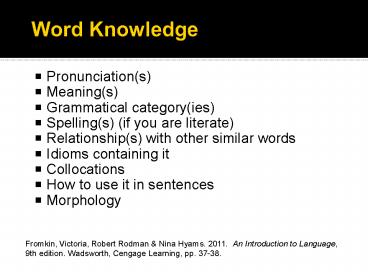Word Knowledge - PowerPoint PPT Presentation
Title:
Word Knowledge
Description:
Pronunciation(s) Meaning(s) Grammatical category(ies) Spelling(s) (if you are literate) Relationship(s) with other similar words Idioms containing it – PowerPoint PPT presentation
Number of Views:49
Avg rating:3.0/5.0
Title: Word Knowledge
1
Word Knowledge
- ? Pronunciation(s)
- ? Meaning(s)
- ? Grammatical category(ies)
- ? Spelling(s) (if you are literate)
- ? Relationship(s) with other similar words
- ? Idioms containing it
- ? Collocations
- ? How to use it in sentences
- ? Morphology
Fromkin, Victoria, Robert Rodman Nina Hyams.
2011. An Introduction to Language, 9th edition.
Wadsworth, Cengage Learning, pp. 37-38.
2
Receptive vs. Productive Vocabulary
3
Receptive and Productive Vocabulary
4
Limited Vocabulary Knowledge
- plan
- contact with vs. contact NO WITH
- star
- geyser
5
Vocabulary Size
- Number of words
- ? 1 1/2 year old 20-50
- ? Six-year-old 13,000
- ? High school graduate about 60,000
- ? College student more
Fromkin, Victoria, Robert Rodman Nina Hyams.
2014. An Introduction to Language, 10th edition.
Wadsworth, Cengage Learning, p. 33.
6
Word Boundary Problems
- Mairzy doats and dozy doats
- And liddle lamzy divey
- A kiddley-divey too,
- Wouldnt you?
- Mares eat oats and does eat oats,
- And little lambs eat ivy
- A kidll eat ivy too,
- Wouldnt you?
Fromkin, Victoria, Robert Rodman Nina Hyams.
2003. An Introduction to Language, 7th edition.
Boston, MA Thomson Wadsworth, p. 70.
7
Words Spoken in Context
- you
- See you (later).
- Did you go?
- Did you eat that already?
- Did you eat yet?
- No, did you?
8
Dictionary Types
- General
- Monolingual
- Bilingual
- Etc
- Specialized
- For computers
- For business
- For chemistry
- For engineering
- For linguistics
- Etc
Fromkin, Victoria, Robert Rodman Nina Hyams.
2011. An Introduction to Language, 9th edition.
Wadsworth, Cengage Learning, p. 38.
9
Morphology
- The study of the internal structure of
- words, and of the rules by which words
- are formed, is morphology.
Fromkin, Victoria, Robert Rodman Nina Hyams.
2014. An Introduction to Language, 10th edition.
Wadsworth, Cengage Learning, p. 37.
10
Morpheme
- A morphemethe minimal linguistic signis thus
an arbitrary union of a sound and a meaning (or
grammatical function) that cannot be further
analyzed.
Fromkin, Victoria, Robert Rodman Nina Hyams.
2014. An Introduction to Language, 10th edition.
Wadsworth, Cengage Learning, p. 38.
11
Examples of Morphemes
- 1 boy
- 1 desire
- 2 boy ish
- 2 desire able
- 3 boy ish ness
- 3 desire able ity
- 4 gentle man li ness
- 4 un desire able ity
- 7? anti dis establish ment ari an ism
Fromkin, Victoria, Robert Rodman Nina Hyams.
2014. An Introduction to Language, 10th edition.
Wadsworth, Cengage Learning, p. 38.
12
Bound Morphemes
- ? Affixes
- Prefixes
- Suffixes
- (Infixes)
- (Circumfixes)
- ? Roots
- ? Stems
13
Unaffixed Bound Roots
- It had been a rough day, so when I walked
into the party I was very chalant, despite my
efforts to appear gruntled and consolate. I was
furling my wieldy umbrellawhen I saw her. She
was a descript person. Her hair was kempt, her
clothing shevelled, and she moved in a gainly
way. Emphasis added
How I Met My Wife, by Jack Winter. The New
Yorker, July 25, 1994. Reprinted in Fromkin,
Victoria, Robert Rodman Nina Hyams. 2014. An
Introduction to Language, 10th edition.
Wadsworth, Cengage Learning, p. 43.
14
English Inflectional Affixes
- VERB
- -s
- -ing
- -ed
- -en
- NOUN
- -s
- -s
- ADJECTIVE
- -er
- -est
Fromkin, Victoria, Robert Rodman Nina Hyams.
2014. An Introduction to Language, 10th edition.
Wadsworth, Cengage Learning, pp. 46-47.
15
Next Weeks Prize Puzzle
- Give me an example IN CHINESE of (Prize for first
answer for each) - 1. A Character that is NOT a Morpheme (Usually
they are.) - 2. A Morpheme that is NOT a Syllable (Only one
exception.) - 3. An Infix in Chinese (There are maybe 3)
16
Chinese Characters / Words
- 1 Chinese character
- 1 morpheme (usually)
- 1 Chinese character
- 1 syllable (1 exception)
- 1 Chinese word
- 1 or more morphemes/characters

